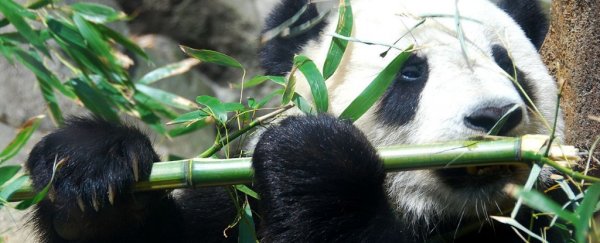For most of us, the jump from meat-eater to vegetarian is a big one. For the giant panda, the switch was all too easy. Despite a long family history of meat-heavy meals, this large bear now feeds almost exclusively on tough bamboo – a change its ancestors made more than 2 million years ago.
For that reason and by all appearances, the giant panda (Ailuropoda melanoleuca) is a herbivore. But escaping your roots has never been easy, and from one dietary perspective this black-and-white bear remains just as much a carnivore as many of its relatives.
Even though the giant panda has long-eschewed all meat, new research suggests that it continues to eat like a wolf (quite literally).
After years of tracking the animal's eating habits, scientists have now revealed that its favourite bamboo shoots are basically a kind of faux meat, given they're absolutely brimming with protein.
And pandas know it. Over the years, the researchers watched as these creatures climbed to ever greater heights, following the young shoots with low fibre content and high protein.
With half the panda's energy coming from protein alone, the researchers conclude that the bear's diet is less like a herbivore and more like a hyper-carnivore, similar to a feral cat or wolf. In fact, it's left the team wondering if the term 'herbivore' can even fully capture the true quirkiness of this giant mammal's diet.
"Based on what they eat, they absolutely belong to the herbivores, but considering the macronutrient composition of the ingested and absorbed diets, they belong to the carnivores," says researcher Fuwen Wei from the Chinese Academy of Sciences in Beijing.
Perhaps the giant panda is doomed to forever sit on this categorical fence. Over millions of years of evolution, the bear developed jaws, teeth and thumbs ideal for handling bamboo, but deep inside it holds a bloodthirsty secret that has largely gone unnoticed.
Unlike a herbivore, its digestive tract is short and unsuited to fibre digestion, while the enzymes and microbes in its gut speak volumes of its Carnivora clade. Both the panda's milk and poo were also found to contain high levels of protein, with the milk especially reminiscent of what carnivores suckle, in terms of its macronutrient makeup.
"In giant pandas, a short, carnivorous gut facilitates rapid throughput, and the high abundance and easy accessibility of bamboo enable large amounts to be eaten, compensating for low digestive efficiency," the authors explain.
In short, the findings suggest that giant pandas had to undergo few evolutionary adaptations to make the switch from meat to bamboo. There, sitting in front of them, was a seemingly endless source of protein-rich food that had everything they needed. All they had to do was eat a lot of it.
"If you're going to switch to a specific plant, bamboo isn't too bad, as it does have respectable plant protein levels, as well as a swathe of different vitamins," bacteriologist Garret Suen from the University of Wisconsin at Madison, who wasn't involved with the study, told The Atlantic.
Far from being an abrupt or extreme leap, as many have assumed, the argument for vegetarianism might have been easy for the giant panda to swallow.
This study has been published in Current Biology.
